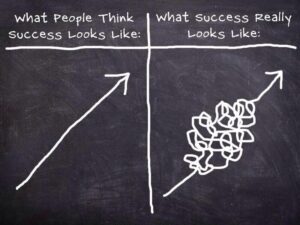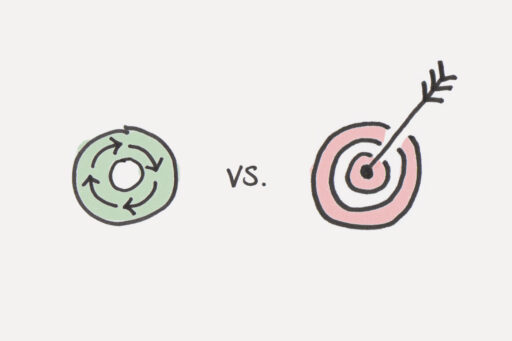How to develop Grit

What is the secret of super achievers?
They can create and sustain their motivation for their long term goals. Whatever life throws at them, these people are ruthless in their undertaking and ferociously determined to keep grinding on. They are aware that sacrifice in the short term allows them to achieve something of greater value later.
This capacity to create sustained effort and motivation is what separates winners from the losers. If it would be one word that would describe this mindset, the word would be Grit.
The essence of Grit
Grit is a combination of passion and perseverance that allows you to deal with life impediments and setbacks. By definition, the path to success is always full hurdles and obstacles. Knowing this, striving for success also means going into untrodden terrority and facing failures and moments of doubt. But grit is exactly meant to deal with those moments, overcoming obstacles while making sure you stay on the right path.
In order to develop grit in your daily lifestyle, here are six methods to help you create and sustain motivation:
- Design a system and focus on the effort
- Create a Ulysses pact with a peer
- Use loss aversion to create motivation
- Invest in your goals
- Use rituals to condition motivation
- Link a reward to create motivation
Before diving into each method, I dive into the specifics of Grit.
The Road to Success
When we decide to start working on a long term goal we might build up momentum and we are feeling motivated to do our best. There will be times however, when we will fall short on energy, the challenge is too difficult, or we start doubting our own resolve.
Can I really do this?
Am I doing enough?
What if I don't make it?
This feeling of doubt is a universal experience we all encounter in life. Forget about why you are doubting, and think about how the choice will define you as a person. Because it is in this moment of doubt and the choice that follows, that you are setting the stage for your own potential.

Success will never be achieved in a straight line, so quitting isn't an option when in a moment things don't go your way. Individuals with grit realize that times can be tough, but that adherence to the essential steps will get them through it. They realize that talent is a given, potential is one thing, and what you do with potential is another.
Fire needs wood to burn
In a similar scenario, we might feel enthusiasm instead of doubt when we work on goals. Unfortunately, enthusiasm is only a temporary burst of energy created by the novelty of our interest. This fire will wither at some time, along with the motivation we felt.

Growing grit from the inside out
Angela Duckworth, the author of the book grit, suggests that grit can be grown from the inside out. She mentions and describes 4 assets that we can call upon to develop sustained effort and motivation.
Passion
The first asset is passion. True passion is about staying in one field of endeavour and not switching because you are seeking novelty. Although the goal you are striving for isn't close, you still stay on the path, working towards those distant objects in the future. Long after the initial interest withers, passion is what keeps us engaged with our hearts. It offsets the energy for the activities and habits that are required for the fulfilment of the goals we have set - so that ultimately we will become more than what we were.
Practice of discipline
With the practice of discipline, we force ourselves to persevere. By tenaciously sticking with our goals all the way and by devoting ourselves to the challenge, we aim to become better than yesterday. Although we know the road to mastery may be long, we know we get closer every day. As a result, setbacks are just that: setbacks, nothing more and nothing less. It is the quiet determination, the degree of strength and the ability to follow through that characterizes individuals that persist in their actions.
Purpose
Your purpose is the reason and motivation behind all the aligned small actions you perform in everyday life. It is the reason in the back of your mind, why it is important for yourself or others, that you achieve your goal. Purpose gives you a clear big picture of the meaning of your actions once they stack up towards the end-result. One way of creating an engaging why is to extend purpose beyond yourself. How will others benefit from your actions? You can still have a purpose that is focused on yourself, because only the best version of yourself can give the best to the world. So focus on becoming that person. And after you learn and master something in life, you can help others who are facing the same problems too.
Hope
Hope is the underlying factor that keeps the dream alive at all times. It is hope - knowing there is a possibility to achieve the end result - that gives super achievers the resolve to make tomorrow better. With hope, they design their daily life meticulously. This way they are able to bundle small daily actions together to create superlative performance. As sociologist Dan Chambliss in the book Grit explains what this type of performance means.
"Superlative performance in life is actually the confluence of dozens of small skills and activities, synthesized together into a whole and drilled into habit. There is no extraordinary action in itself, just the culmination of consistent and correct action that will lead to excellence over time."
This is the bottom line. Individuals with grit understand that life isn't determined by talent, or innate gifts of skill. No. They realize that talent doesn't say much about success. Talent might determine your potential, but effort is how you actualize your potential. Effort counts twice and individuals with grit use that to their advantage.
Six methods for sustained effort and motivation
In order to develop grit, we have to realize that there are distractions and psychological roadblocks in the mind that prevent us from achieving your goal. So, the most important thing to realize is that the development of grit is simply a mind game against yourself. When you are about to quit, you have to make sure you have reasons not to quit. This means that it is crucial to understand what your personal pitfalls are in your own behaviour, so that you can create counter conditions that will ensure you sustain your effort anyway.
Method 1. Focus on a system instead of goals

In order to achieve a goal, we can use a system. The goal of the system is not the goal itself, but the consistency of behaviour that will lead to the achievement of the goal. Essentially, a system is about putting in the effort regardless of the result. The truth is that we need an easy way to summon our willpower that allows us to start working on our goals right away and every day. Here we can adopt what is called 'the decent system'.
Instead of creating the perfect plan, it is much more effective to create a decent system; something that you wont quit. On the one hand, yes, the perfect plan will show you exactly what to do, when and how. On the other hand, the decent system (although not perfect) is something that you can stick to over the long run in order to ensure sustained effort and motivation.
Therefore, the decent system prioritizes results over planning and perfection. It is actually much easier to start with a decent system that gives results than trying following the perfect plan to the T. This also prevents you getting bogged down by inertia by not starting, or stopping when things don't go your way as planned. The system is unaffected such setbacks, because it functions as an approach to tackle your daily tasks. In this case, starting in some way is always better than never beginning. That is why shipping beats perfection.
Method 2. Create a Ulysses pact with a peer
Making a Ulysses pact means that you are freely making a decision that is designed to bind oneself in the future. The origin of the name refers to the Greek Ulysses, that made a pact with his men as they approached the Sirens.
"Ulysses wanted to hear the Sirens' song although he knew that doing so would render him incapable of rational thought. He put wax in his men's ears so that they could not hear, and had them tie him to the mast so that he could not jump into the sea. He ordered them not to change course under any circumstances, and to keep their swords upon him and to attack him if he should break free of his bonds"
The story symbolizes the pact you should make by involving other people to make sure you stay on the planned course. Creating a pact with yourself and a peer is a strong method to create adherence. Just like Ulysses, we also have sirens, but they live in our minds. They are constantly trying to hypnotize us into changing course. So be smart and take away your free choice by creating a pact with your peers. Although we cannot stop the sirens from singing, we can ensure that we follow up on desired behaviour when the moment of truth arrives.
Choice minimalism
Creating a Ulysses pact is about minimalizing choice. In other words, focus on avoiding decision fatigue - by relieving your mind from having to make a choice. Choice minimalism is a great method for creating sustained effort and motivation because the desired behaviour is being set as the default so your brain can go on autopilot and not worry about the choice itself. This means more willpower, and more willpower means more effort.
Just like Ulysses, you have to make a pact with a peer so that you will be tied up and unable to change your course. To assure that you go into the right direction, you can create social responsibility towards somebody else.

Adopting a sports activity
Create accountability by involving a peer in your workout schedule. Make them aware of your goals and new desired behaviour or let them be a part of it. For example, let them know you are going the gym on Tuesdays and Thursdays and that you will send them a picture when you are there in the gym as proof of evidence. Also tell them you are not allowed to cancel without a good excuse and if you do, they can think of something funny or stupid you have to do. Beforehand, find a strong moment in which you can create this preliminary promise with your peer so you can follow up on it when the tough times come. This way, you can push yourself beyond the point of doubt. You might try to convince yourself last-minute that you don't have to go to the gym, but due to the context you have set your brain will not be thinking about cancelling, because it would have consequences you do not want to obtain.
Eating more healthy foods
Create accountability by involving a peer in your meal schedule. Do groceries for the whole week based on your new diet. Purchase foods up front, to avoid distraction and contemplation of bad foods when your willpower is low. You can let your peer know you are following a healthy lifestyle. Also give them comments on your daily progress. We do not like peer disapproval, so this can be a powerful factor to ensure you prepare the healthy meal in the first place. Having responsibility to yourself is one thing, but responsibility towards others often works better.
Learning a new skill or language
Create a learning schedule and share this with your peer. You can start small, for example reading or studying for 10 minutes per day after dinner. Also tell your peer that each evening you will send them a summary or lesson with what you learned. Make sure you are specific and precise in terms of what you are going to do and report on.
Last but not least, do these things for the adoption of the process and not necessarily the result. Use the opportunity to share your goals with your peers. Having a responsibility buddy can really help you take things seriously because you are creating interaction regarding your personal initiative in your daily life.
Method 3. Use loss aversion to create motivation
Our brain is highly attuned to loss aversion. Loss aversion simply means that we are more attuned to avoiding losses than acquiring equal gains. As a result, it's more important not to lose 5$ than to win 5$. We want to use this perspective to our advantage by framing behaviour in a way so that you are risking to lose
something. This is a powerful method you can use to comply with yourself to create some real skin in the game.

Lose, but only if you don't comply
Peer accountability can also be used to create loss aversion and it works exceptionally well to create sustained effort and motivation. For example, make an agreement with a peer that you will go work out 3 times a week for x amount of weeks. Up front, give that person an amount of money and ask him or her to return 10 dollars / euros for each session. This will ensure that you are motivated to get the money back by simply adhering to what you set out to do in the first place. Compliance is maybe not the best way to create sustained effort and motivation over the long time, but it can help us start.
This method can be used for practically anything. Just make sure that what you are giving up is something you truly want to get back. Although a financial incentive is the easiest way to go, other incentives are possible too. Be creative and give something up that truly means a lot to you.
Method 4. Invest in your goals
Another but similar method is to invest in the goals you set out to achieve. This can create the motivation in yourself to get a return on the investment that you make. This cognitive bias is part of the sunk cost fallacy, which states that we are prone to put in the effort if we have invested in something beyond the point of no return. So, make sure that the investment is big enough so you want to earn a return on it.
For example, if you buy sports clothes. Buy many of them instead of just one. Once you buy them, you might as well use them. The same goes for groceries. If you buy lots of healthy food, you
might as well eat it. Similarly, don't buy one book but buy 5 or 6. Then you might as well read them all! Use the feeling of regret against yourself. Either you feel empowered by using the things, or you feel even worse for not using them.
Method 5. Use rituals to condition motivation
Rituals can be used to condition yourself to relate one activity to another. This means that doing activity A also means doing activity B. Although it takes intentional effort for the first few times, implementing rituals can truly make a difference in the long term because you are sustaining the correlation between two activities until it becomes a natural pathway for you to take.
For example:
- After dinner I will take the effort clean my house / read a few pages of my book.
- After waking up I will take 3 minutes of effort to make my bed while thinking about my goals for the day. I then write down my goals and things I'm grateful for.
- When I come home from work, I immediately put on song X. Until the end of the song I will sit in a corner and focus on deep breathing. After that I will continue meditating for 10 minutes.
Method 6. Link a reward to create motivation
There are two ways to link a reward to the desired behaviour. The first way is called temptation bundling, which is bundling an obligatory task with an enjoyable one. This hacks your motivation because the obligatory effort suddenly becomes positive through the association with the enjoyable task. This can be for example listening to music while you are running. Pairing activities like this can be effective, but it doesn't work in all case, depending on the nature of the obligatory task at hand.
There is also a stronger method available to us and it is called delayed gratification. Basically, delayed gratification means that the reward for a specific action is delayed to an certain extent, until the desired behaviour is executed. The reward itself is still in the near future instead of far away, but it is conditional - meaning that it requires an act from us beforehand to earn the reward.
Delayed gratification has become popular with the Marshmallow experiment, developed by Stanford psychologist Walter Mischel in the late 1960s. In the experiment, children were given a marshmallow with the promise that if they would not eat the marshmallow, they would get another one if they waited for 15 minutes.

Some children neglected the statement. Others focused on the marshmallow with all their attention while trying not to eat it. Others tried to distract themselves, not looking at it by closing their eyes or turning away. Ask yourself to what extent you can employ your own motivational reasoning, doing or not doing something now to later get a reward for it.
In other words, we can provoke the desired behaviour in ourselves by delaying the gratification we would normally have immediately (for example some sweets / cookies, or by using that tv show you are watching as leverage).
The marshmallow experiment has become a prime example of our natural tendency to prefer short term rewards over long term rewards. Although the experiment has received some contradictory evidence lately, the important lesson we should take from it still stands: Delaying gratification is a powerful force that we can use to our advantage to make ourselves comply (read more about delayed gratification here).
Creating sustained effort and motivation
In conclusion, becoming a super achiever is about creating consistent action over time. Apply the concept of grit - with passion, purpose, the practice of discipline and hope - to create a strong mindset of not giving up. Additionally, use the six methods provided to resolve mental roadblocks and impediments in your daily lifestyle. This will dramatically increase your chance to create sustained effort and motivation, so you can stay adherent to your long term goals.
References
https://mathequalslove.blogspot.com/2015/08/free-grit-poster.html
https://www.tripadvisor.com/LocationPhotoDirectLink-g43286-d3728652-i346065155-Bonfire_Wood_Fire_Cooking-Mankato_Minnesota.html#346065155
Duckworth, A. (2016). Grit: The power of passion and perseverance. New York, NY, US: Scribner/Simon & Schuster.
https://boingboing.net/2016/06/24/how-to-protect-the-future-web.html
https://en.wikipedia.org/wiki/Ulysses_pact
http://pacificbarbell.com/decision-fatigue/>
https://commons.wikimedia.org/w/index.php?curid=67117183
https://en.wikipedia.org/wiki/Stanford_marshmallow_experiment
https://www.pbs.org/newshour/show/resisting-marshmallow-success-self-control




Comments are closed.